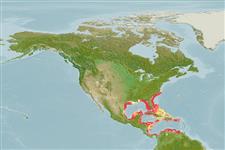Classification / Names
Common names from other countries
Main reference
Size / Weight / Age
Max length : 107 cm TL male/unsexed; (Ref. 89707); common length : 30.0 cm TL male/unsexed; (Ref. 3708); max. published weight: 14.2 kg (Ref. 40637); max. reported age: 21 years (Ref. 6846)
Environment
Marine; brackish; reef-associated; oceanodromous (Ref. 51243); depth range 30 - 100 m (Ref. 5222), usually 30 - 100 m (Ref. 5222)
Climate / Range
Subtropical, preferred 22°C (Ref. 107945); 41°N - 8°N, 98°W - 25°W (Ref. 5222)
Distribution
Western Central Atlantic: Gulf of Mexico and east coast of US from North Carolina to Key West and along the southern shore of the Caribbean Sea. Juveniles are occasionally found as far north as Massachusetts.
Countries | FAO areas | Ecosystems | Occurrences | Introductions
Short description
Dorsal
spines
(total): 11;
Dorsal
soft rays
(total): 16-18;
Anal
spines: 3;
Anal
soft rays: 10 - 12. Distinguished by the following characteristics: four color patterns, first is brown phase with head and body pale brown covered with small reddish brown spots that extend onto median fins, second is cat's paw phase with pale brown body color with dorsolateral parts of body having several clusters of dark brown spots resembling the paw print of a cat, third is with large adults with grey-head phase with the rear two-thirds of the body dark, head and body anterior to the 6th dorsal-fin spine in silvery grey with dark reticulations and fourth is bicoloured phase with pale brown anteriorly and abruptly dark chocolate brown posteriorly; depth of body contained 3.0-3.4 times in SL; head length 2.6-3.0 times in SL; convex interorbital area; angular preopercle, angle with distinct bony lobe; serrate interopercle and subopercle; posterior nostrils of adults 2-4 times larger than anterior ones (Ref. 89707).
IUCN Red List Status (Ref. 115185)
Threat to humans
Harmless
Human uses
Fisheries: highly commercial; gamefish: yes
Tools
Special reports
Download XML
Internet sources
Estimates of some properties based on models
Phylogenetic diversity index
PD50 = 0.5000 many relatives (e.g. carps) 0.5 - 2.0 few relatives (e.g. lungfishes)
Trophic Level
4.5 ±0.0 se; Based on diet studies.
Resilience
Low, minimum population doubling time 4.5 - 14 years (K=0.09-0.17; tmax=21)
Vulnerability
High to very high vulnerability (68 of 100)
Price category
